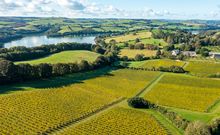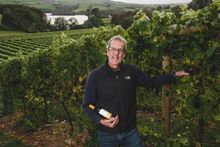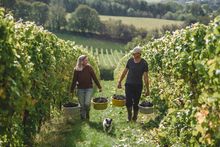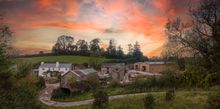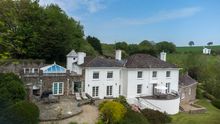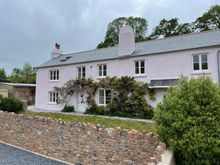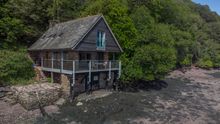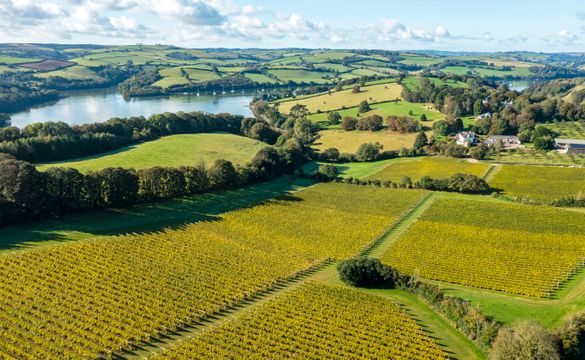 09 Mar 2022
09 Mar 2022
Sandridge Barton, the home of Sharpham Wine, is proud to unveil its brand new visitor centre, winery and restaurant nestled in the South Devon countryside on the east bank of the River Dart. Perfect for a weekend away to the South West of England or a summer's day out, Sandridge Barton will open its doors in early June 2022, in time for English Wine Week (18th - 26th June 2022).
The visitor centre has been created within the traditional buildings of the historic Lower Well Farm, with the central courtyard providing an exceptional seating area overlooking the surrounding countryside, including a spring-fed tributary leading to the River Dart nearby.
Exeter-based, Circa, has been named as the catering partner for the restaurant, which is based within the visitor centre. Open for lunches throughout the season, the on-site restaurant will offer a relaxed atmosphere, both inside and on a south facing sun terrace using only the best local and seasonal produce.
From June, Sandridge Barton will host a range of experiences including guided and self-guided tastings, giving visitors the opportunity to learn about the different grape varieties grown on-site and the techniques used in the winery to craft each style of wine. There are walking trails through the estate and vineyards to explore as well as the opportunity to enjoy wines by the glass in the gallery bar or lunch in the courtyard. There will also be a shop stocking the full range of wines as well as Sharpham Dairy cheeses and other local produce to take home.
Vines were first planted at Sandridge Barton in 2008. Pinot Noir, Bacchus, Chardonnay, Madeleine Angevine and Pinot Gris are now grown in the vineyards which spread across 32 acres of the 400 acre estate. The Sandridge Barton estate is positioned just south of the village of Stoke Gabriel, which is a few miles upriver from the ever-popular town of Dartmouth and a few miles downriver from Totnes. Rich in history, most of the land falls into the South Hams AONB.
A vineyard called Stony Field, which is on a limestone ridge, was recently planted. Some of the premier wine districts in the world are planted on limestone and this, coupled with the increase in popularity of English Wines, sets an exciting future for the wines produced at Sandridge Barton.
Duncan Schwab, CEO and head winemaker of Sandridge Barton, comments: “We are excited to welcome visitors to our new home. In the past, when we were positioned on the Sharpham Estate, we had around 20,000 people a year visit us and we expect a similar number of visitors at Sandridge Barton. With the investment in the new tanks, barrels and other vital pieces of winemaking equipment we are anticipating an excellent showcase of wines this year, amongst the very best produced here in England.” Duncan continues: “The visitor centre and restaurant will put us on the map as the must-visit destination this summer. We are really looking forward to sharing this new experience with guests from around the country and further afield.”
Sandridge Barton will be launching its new Summer Sparkling in time for the opening. Sharpham Summer Sparkling is a fun, fresh pink sparkling wine which is best enjoyed with friends on a hot summer day.
The Sandridge Barton estate also has holiday accommodation. In the Main House, which is located close to the vineyard and overlooks the River Dart, there are six bedrooms and an indoor swimming pool. The newly-renovated Farmhouse at Lower Well Farm has four bedrooms located by the winery and visitor centre. The Boathouse has two bedrooms and is located in total seclusion on the bank of the River Dart. All guests will have the opportunity to experience the offerings of the visitor centre.
To keep up to date with all of Sandridge Barton, the home of Sharpham Wine, news and developments 'like' Sandridge Barton Wines on Facebook, 'follow' @sharpham_wine - Sandridge Barton Wines on Instagram or Sandridge Barton (the home of Sharpham Wines) on Twitter or visit www.sandridgebarton.com.
ENDS
For further information, photography or for an interview with Duncan Schwab please contact:
Hayley Reynolds, RAW Food and Drink PR, Mobile: 07887 474 104
Hayley@rawfoodanddrinkpr.co.uk
Notes to editors
- Sharpham Wine maintained one of Britain's oldest vineyards, planted in 1981 on the Sharpham Estate on the west bank of the River Dart close to Sandridge Barton. Once the nearby Sandridge Barton vineyard was established grapes from there were supplied to Sharpham Wine. Sharpham Wine has now moved downriver to its new home at Sandridge Barton.
- The Sandridge Barton estate operates as a small mixed farm with arable, pasture (for a prize herd of South Devon cattle), orchards and vineyards. It has a diverse landscape with extensive woodland, streams, ponds and abandoned quarries. Lower Well Farm forms part of the estate and was until recently a run down dairy farm prior to its rejuvenation by the construction of the winery and the conversion of traditional barns into the winery visitor centre.
- Sharpham cheeses will continue to be made on the Sharpham Estate and will be sold through the shop at Lower Well Farm, which will continue the Sharpham brand. The dairy produces a range of cow and goat milk cheese to national and international acclaim. With milk from their own herd of Jersey cows, plus goat and sheep milk from their neighbours, they produce handmade cheeses full of character and flavour which reflect this part of Devon.
- Iron age and Roman remains have been found on the Sandridge Barton estate. Sandridge Barton was the birthplace in c1543 of the Elizabethan navigator and explorer John Davis, mapper of the Davis Straits between Greenland and Labrador, and discoverer of the Falkland Islands. An image of his ship, the Desire, is on the Falkland's coat of arms. He grew up at Sandridge Barton and owned it until he was killed in 1605 by Japanese pirates on the coast of Malacca in the East Indies. His childhood neighbours and lifelong friends were the explorers Humphrey Gilbert (who founded the colony of Newfoundland) and Adrian Gilbert, and their half-brother, Walter Raleigh. He was the foremost navigator of his time, and apart from the maps and records that he left including of his three attempts to find the NorthWest Passage, his voyage to the South Atlantic and four voyages to the East Indies, he wrote two scientific books on navigation, invented the Davis backstaff that was used in navigation for two hundred years, and developed the model for ships' log books.
- In more modern times, US forces were stationed at Sandridge Barton during WWII pending their departure for Normandy and there are signs of their presence, particularly from carvings on beech trees in the woods along the River Dart. The woods also contain the remains of an Auxiliary Unit Operations Base from WWII, a secret auxiliary army unit mostly made up of local gamekeepers and farmers who knew the land and who were to engage in irregular warfare in the event of invasion by Nazi Germany, with a projected life expectancy of twelve days from invasion.

